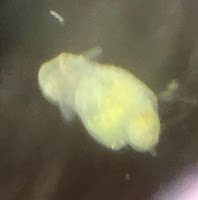Isotopes

Recently, I've found myself wondering a lot about how larvae get nutrition. I know, it's a common dilemma. Every person has at one point in their life sat on a park bench, gazed off at the shoreline, and wondered how they could best tell if a larva was planktotrophic or lecithotrophic. The experience is almost universal. One of the larvae I collected for my stable isotope test. There is a way to tell what organisms are eating - several very good ways, in fact. You can trace specific molecules that organisms have to acquire from their diet. Or you can look at the ratios of isotopes like carbon-13 to tell how high up in the food web your species is. There are a range of options ranging from the general to the specific - but rarely are they used on larvae. Part of the reason might be that larvae are too small. You need a large amount of tissue for some of the specific analyses, which larvae just don't have. They're tiny. But for a general analysis using stable isotopes,